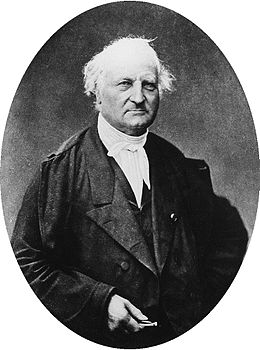Antoine Jérôme Balard
This article needs additional citations for verification. (January 2013) |
Antoine Jérôme Balard | |
|---|---|
 Antoine Jérôme Balard in the 1870s | |
| Born | 30 September 1802 |
| Died | 30 April 1876 (aged 73) Paris |
| Nationality | French |
| Known for | discovery of bromine |
| Awards | Royal Medal (1830) |
| Scientific career | |
| Fields | chemistry |
Antoine Jérôme Balard (30 September 1802 – 30 April 1876) was a French chemist and one of the discoverers of bromine.
Career
Born at Montpellier, he started as an apothecary, but taking up teaching he acted as chemical assistant at the faculty of sciences of his native town, and then became professor of chemistry at the royal college and school of pharmacy and at the faculty of sciences. In 1826 he discovered in seawater a substance which he recognized as a previously unknown element and named it bromine.[1] It had been independently prepared by Carl Jacob Löwig the previous year and the two are both regarded as having discovered the element.
This achievement brought him the reputation that secured his election as successor to Louis Jacques Thénard in the chair of chemistry at the faculty of sciences in Paris, and in 1851 he was appointed professor of chemistry at the College de France, where he had M.P.E. Berthelot first as pupil, then as assistant and finally as colleague.[1] Balard also had Louis Pasteur as a pupil when Pasteur was only 26 years old. It was in Balard's laboratory that Pasteur discovered the difference between "right-handed" and "left-handed" crystals while he was working with tartaric acid. Balard died in Paris in 1876.
While the discovery of bromine and the preparation of many of its compounds was his most conspicuous piece of work, Balard was an industrious chemist on both the pure and applied sides.[2] In his researches on the bleaching compounds of chlorine he was the first to advance the view that bleaching-powder is a double compound of calcium chloride and hypochlorite; and he devoted much time to the problem of economically obtaining soda and potash from seawater, though here his efforts were nullified by the discovery of the much richer sources of supply afforded by the Stassfurt deposits. In organic chemistry he published papers on the decomposition of ammonium oxalate, with formation of oxamic acid, on amyl alcohol, on the cyanides, and on the difference in constitution between nitric ether and sulphuric ether.[1] He also helped Louis Pasteur devise the experiment that would prove spontaneous generation to be false.
References
- ^ a b c One or more of the preceding sentences incorporates text from a publication now in the public domain: Chisholm, Hugh, ed. (1911). "Balard, Antoine Jerôme". Encyclopædia Britannica. Vol. 3 (11th ed.). Cambridge University Press. p. 239.
- ^ Pötsch, Winfried R. (1988) "Annelore Fischer and Wolfgang Müller with contributions of Heinz Cassenbaum", p. 25 in Lexikon bedeutender Chemiker, VEB Bibliographisches Institut Leipzig, ISBN 3-323-00185-0.
Further reading
- Wisniak, Jaime (2004). "Antoine-Jerôme Balard. The discoverer of bromine" (PDF). Revista CENIC Ciencias Químicas. 35 (1).
- Charlot, Colette (February 2008). "A.J. Balard, the bromium discoverer". Revue d'histoire de la pharmacie. 55 (356). France: 495–504. ISSN 0035-2349. PMID 18549189.
- Charlot, Colette; Flahaut Jean (2003). "Antoine Jérôme Balard. The man". Revue d'histoire de la pharmacie. 51 (338): 251–64. PMID 14606485.
{{cite journal}}: Cite has empty unknown parameter:|month=(help)
External links
- Antoine Jérôme Balard and Louis Pasteur, PasteurBrewing.com
- Use dmy dates from July 2013
- 1802 births
- 1876 deaths
- People from Montpellier
- French chemists
- Discoverers of chemical elements
- Collège de France faculty
- École pratique des hautes études faculty
- École Normale Supérieure faculty
- Members of the French Academy of Sciences
- Royal Medal winners
- 19th-century chemists
- Bromine
